Kalanchoe Care As A Houseplant & In The Garden
Oh, how I love succulents! And a succulent with lots of long-lasting flowers is just the cat’s meow. Enter the popular Kalanchoe blossfeldianas that are most commonly sold as indoor plants. In Santa Barbara, where I used to live (USDA zone 10), mine enjoyed the great outdoors year-round. This is about Kalanchoe Care indoors and outdoors, or Kals as we call them.
These long, lasting blooming plants with colorful flowers will brighten up both your garden and home. If you want the flowering period to be more long-lasting, buy your plant with at least half the flower buds partially or not yet opened. They’ll gradually open after you get them home.
I buy mine at the farmers market, and although we used them a lot in the interiorscaping trade in offices and homes, I had never grown them in the garden before. I’ve discovered that Kalanchoes bloom almost all year round here with very little care. My kind of plant!
Botanical Name: Kalanchoe blossfeldiana
Common Names: Kalanchoe, Flowering Kalanchoe, Florist Kalanchoe, Flaming Katy
NOTE: This post was published on 07/16/2014. I’m updating it on 06/22/2023. It’s one of the very first posts that I ever wrote. My how blogging has changed!
I’ve since written newer posts on Kalanchoe Care as houseplants. Rather than extensively update this post, I will list these more current posts Kalanchoe Care, Calandiva Care, and Growing Kalanchoe FAQs with more information and tips.
Kalanchoe Care In The Garden
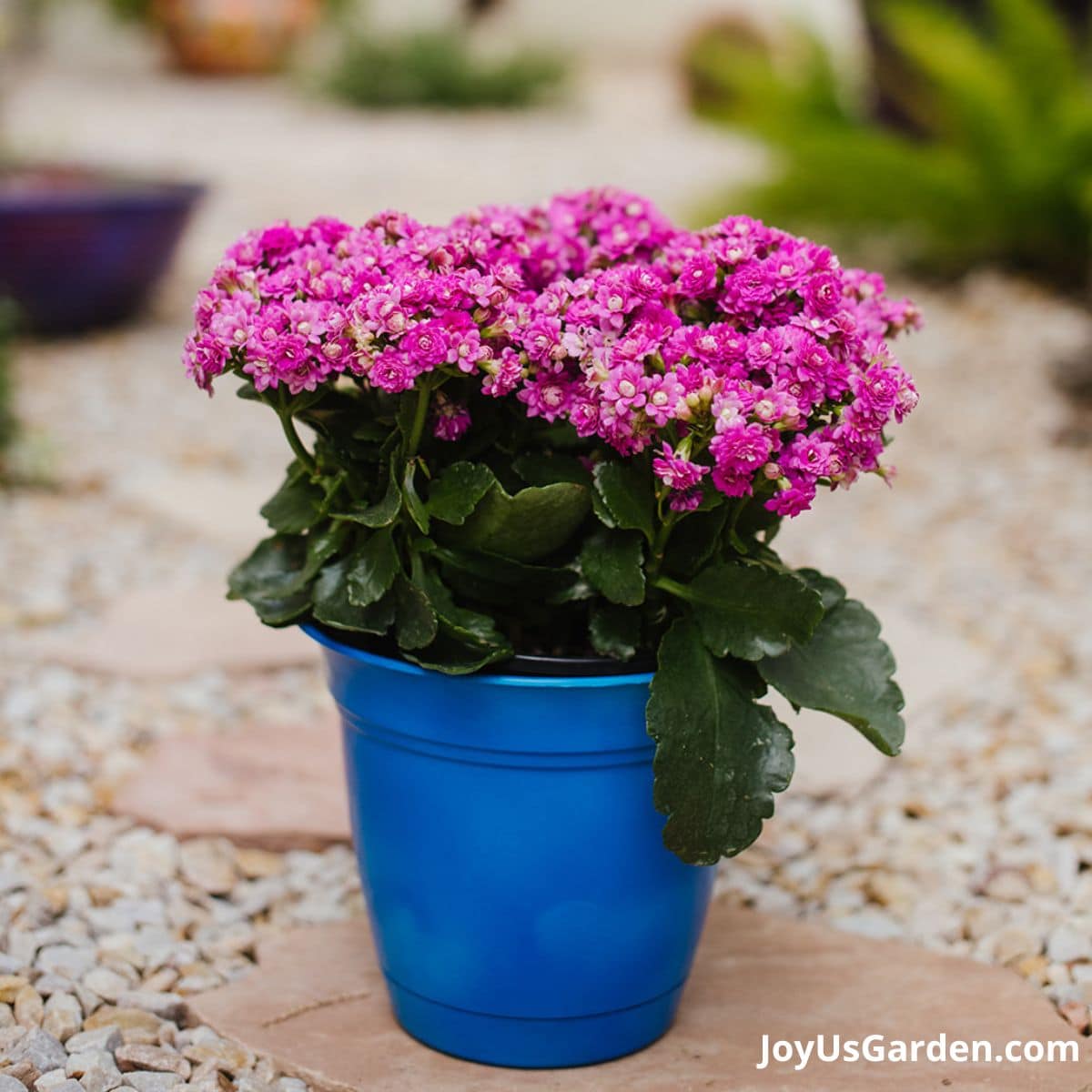
Light Requirements
Bright shade. Mine get bright light and one or two hours of direct sun in the summer, no more. Too much direct sunlight will cause burn.
Water Requirements
Once a week, thoroughly. They’re succulents, so they like to dry out between waterings.
Soil
Mine are planted in pots in half organic potting soil and half Succulent and Cactus Mix. Kalanchoes are succulents susceptible to root rot; they must be planted in well-draining soil.
Fertilizer
I don’t use any. I plant with worm castings, then top dress with worm castings and compost every spring. Once or twice during the warm months, I’ll water in some seaweed extract.
Pests
None so far, but then they can be susceptible to mealybugs and aphids.
Pruning Tip
I trim off the spent flowers, taking the stem down to where it meets the foliage. I don’t have to do it too often because the flowers are long-lasting, and the plant looks better this way.
Kalanchoe Care As Houseplants
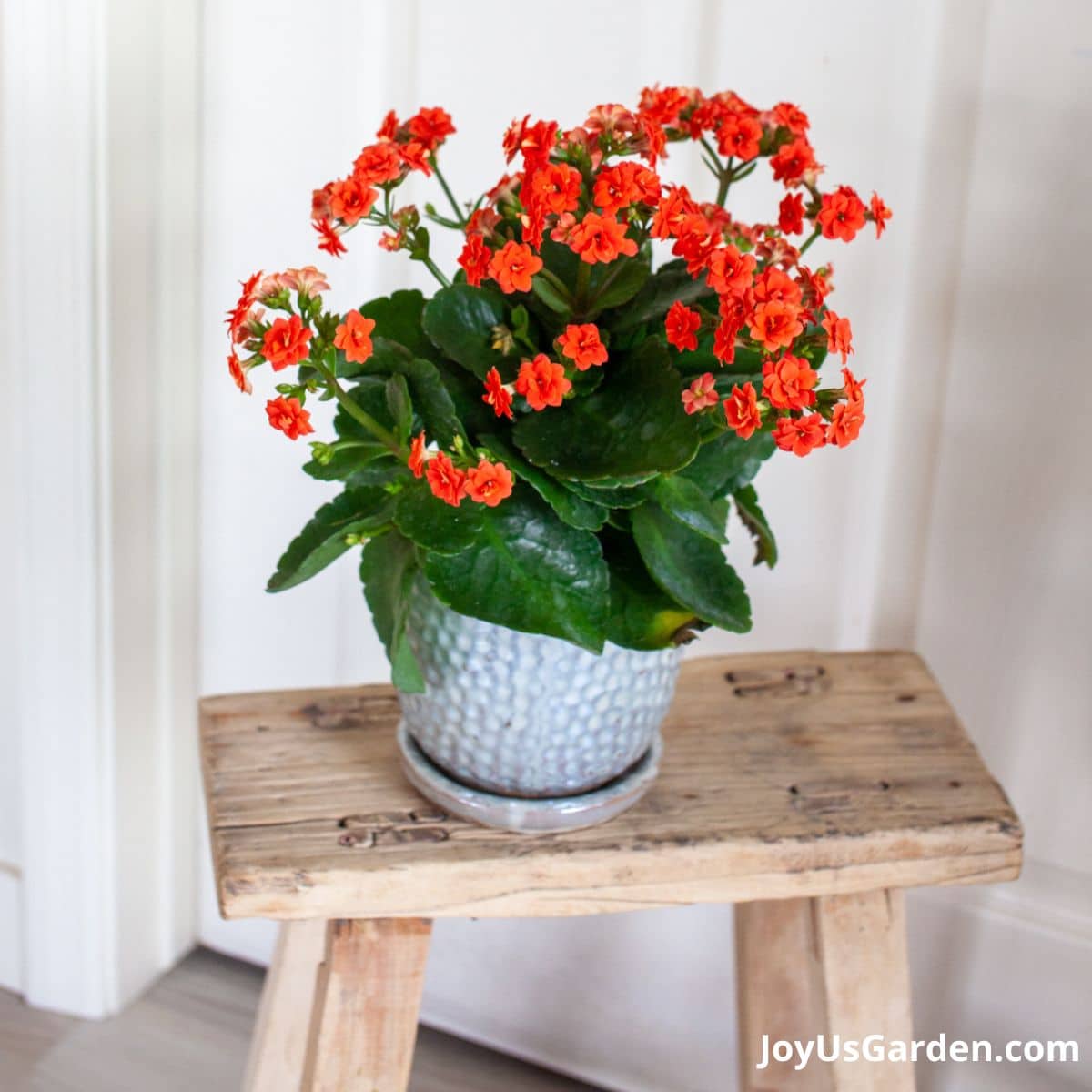
Now, onward to caring for them as houseplants. At the end of this post, I touch briefly on how to get them to bloom again indoors. Hint: it’s not easy.
Light Requirements
Give yours lots of bright indirect light. As bright as possible, something close to but not in a south and/or west-facing window. Keep it away from the hot windows – touching that glass will burn it. Ouch!
Water Requirements
Every two weeks in the warmer months. Wait until the soil drys out before watering again. And don’t let it sit in water. Remember, they’re succulent plants that store water in their fleshy leaves and stems, so keeping them too wet can cause mildew.
Too much moisture will also lead to root rot. They like to be kept on the dry side.
Tip: Yes, that paper or foil wrapping may be prettier than the grow pot but remove it when you water your plant. Remember, the Kalanchoe is a succulent, and too much water building up in the bottom will drown it out.
Soil
Use a potting soil mix formulated for houseplants with good drainage. A mixture of half potting soil and half Succulent and Cactus Mix would be fine. That’s what I used to plant up my new pink Kalanchoes.
Tip: Make sure the pot has drainage holes so the excess water can freely flow out.
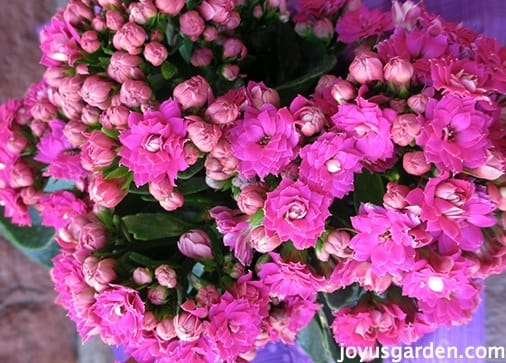
Temperature
I say if your home is comfortable to you, then your houseplants should be just fine too. They would enjoy a vacation outdoors in the warmer months (refer to outdoor care above).
Fertilizer
Use an organic balanced liquid fertilizer like Sea Grow if you feel yours needs it. Easy does it—only two yearly applications – once in mid-spring and the other in mid-summer.
Here are some of our houseplant guides you may find helpful: 6 Low Maintenance Plants For Travelers, 11 Pet Friendly Houseplants, Tips For Buying Houseplants, Best Low Light Indoor Plants, Easy Care Office Plants, 7 Easy Care Floor Plants, 7 Easy Tabletop & Hanging Plants
Pests
Keep an eye out for Mealybugs. They leave behind a residue that looks like specks of cotton. Aphids and Scale can also be an issue.
Pruning Tip
The foliage grows very densely. I snip away some of those leaves growing over the blooms. Those purdy little flowers will show more!
Getting Kalanchoes To Rebloom
Now, on to how to get them to bloom again. If yours hasn’t ever repeat bloomed, don’t feel bad. I’ll start by saying “good luck” because you must work for it.
Kalanchoes, like Poinsettias, are photoperiodic. This means they react to periods of light exposure and need at least 12-14 hours of darkness to bloom again.
Chances are, if you have them in your home, you have them in a room that isn’t getting that amount of complete darkness. Starting in winter, you must put them in a closet or a pitch-black room for 12-14 hours. And yes, they need that every night for two months. Be sure to cut back on the watering too.
Kalanchoe Blossfeldiana Flower Colors
Kalanchoes are known for their beautiful flowers, which come in vibrant red, orange, and pink shades. You can also find them in white and more subtle shades of pink. There are bi-color flowers as well.
The flowers are long-lasting, and the rich green leaves are attractive and shiny. A great blooming plant for the garden or your home!
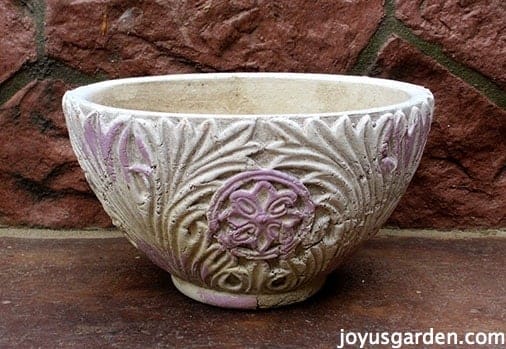
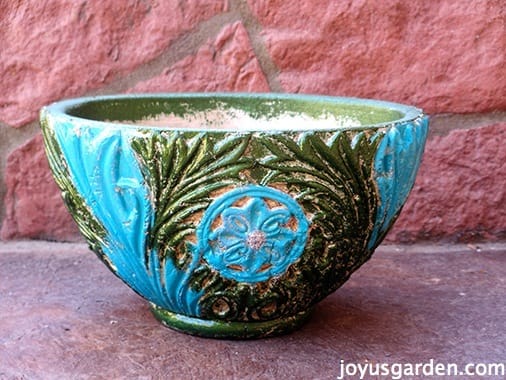
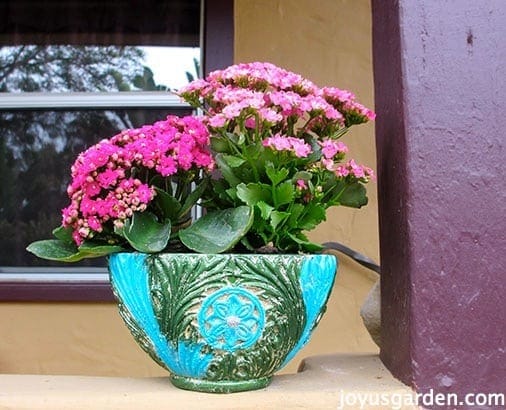
Kalanchoe Care Video Guide
(Warning: This is an old video!)
In conclusion, taking care of a Kalanchoe plant is not as daunting as it may seem. With the right light levels, water, and well-drained soil, your kalanchoe can thrive and bring life to any room in your house or the right spot in your garden.
We have written more current posts on Kalanchoes: Kalanchoe Care, Calandiva Care, and Kalanchoe FAQs with lots more information and tips.
Note: This post was originally published on 07/16/2014 and updated on 06/22/2023.
Happy Gardening,

This post may contain affiliate links, you can read our policies here.

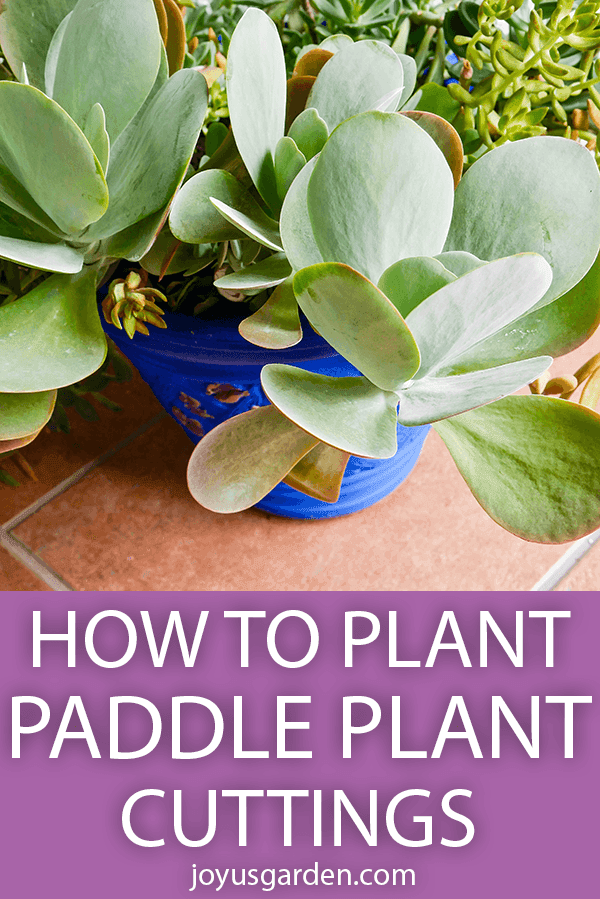
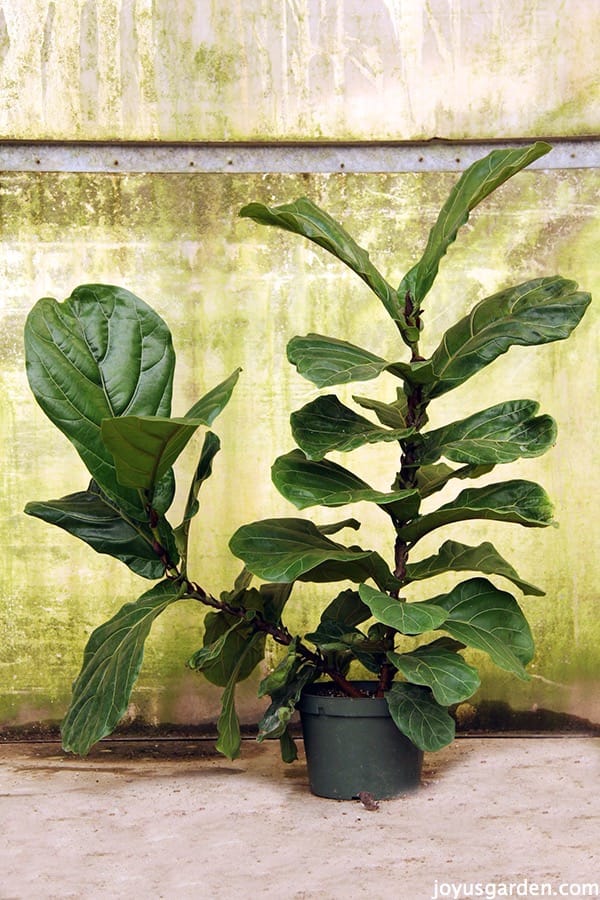
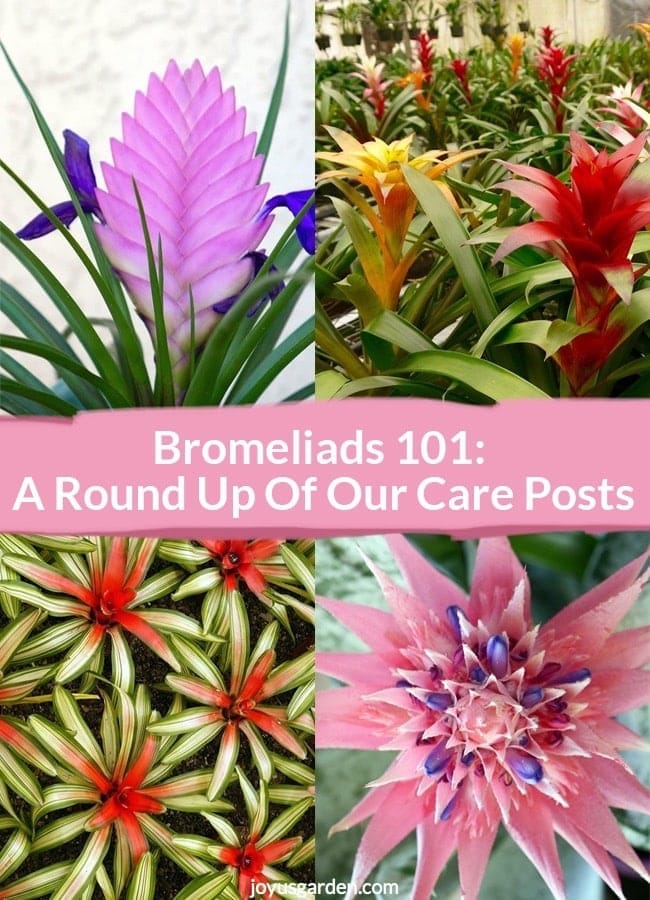
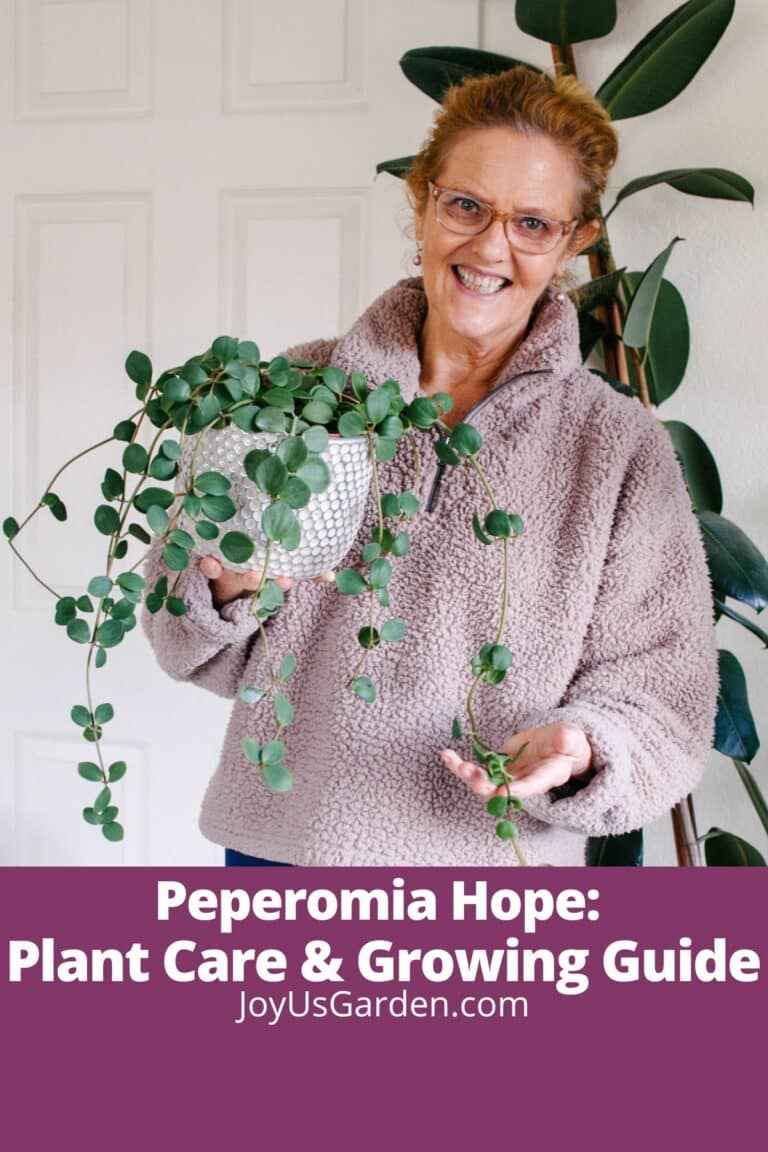

I got a kalanchoe in a bouquet when my Mom passed away August 2013. So it’s sentimental to me. A few months later I pruned and picked off some drying leaves, and just let it regrow. But it just seems to grow up taller with small leaves, though it still looks nice in the window. Should I maybe nip the tips off the stems growing upward?
Hi Ken – Oh those sentimental plants – I so understand. It may not be getting enough light if the leaves are small & the stems are reaching skyward. You can certainly do tip pruning which will encourage it to stay lower & you might even consider doing it every month or 2. My Kanlanchoes grow outdoors & I prune them after every bloom cycle. By the way, because it’s Winter, don’t fertilize it. Even houseplants need a bit of rest! Nell
I also have another issue! you know anything about the giant cannas plant? I rec’d some seeds I ordered and the instructions said it could take up to 6 weeks before they germinate. I searched on youtube about germinating theses seeds and found some techniques that I thought I would experiment with, on a couple of the seeds. they germinated after 3 days and are growing. Here it is early January and its going to be 3 months before I can get them outside. do you think they’ll be able to survive that long in a 4×4″ pot by the window?
Hi Ken – Cannas are a very common landscape plant around here. If you only have 2 seeds in that 4″ pot, they should be fine. They do tend to grow fast, including the roots, so just make sure the soil doesn’t completely dry out. Cannas do not like to go dry when young. They are tough plants & transplant easily (I’ve seen them at the grower’s with pots split open) so if they have look like they have to be repotted in March, no problem. Nell
Nell,
I have a Kalanchoe-Jackie which is into its second bloom. My question is how to control the plant from spreading outward from the center of the pot? Should I us Stick Propagation to refill the center of the pot?
Thank You
Hi Damian – These Kalanchoes spread from the center of the pot to get more light. I propagate them 2 ways with success: leaf cuttings & 4″ stem cuttings taken from that smaller new growth which shoots off the main stems. Hope that helps, Nell
Hi Nell, so glad to have found your site. I live in Southern Florida, on the Gulf Coast near Naples – way down. It is summer most of the year and mine is red, did not know what I was buying, it was just so beautiful I had to have it. It has not stopped blooming, been about 5 months so far. I am just about to put it in the ground and am now rethinking that. I have some big pots and it seems happy in a pot. So, I think I will transplant it to a larger pot, which, I took, am going to paint! You have inspired me. I am 65 and need some inspiration in my life right now and you are helping me fill that void. I thank you.
Dotty
PS I am an avid reader and will read up on propagation, etc .
Dorothy – I’m so glad you found my site too! I live in a temperate climate right on the coast on California but the air is much drier than in Florida. Kalanchoes are succulents & prefer drier conditions so you are wise to keep it in a pot because it could possibly rot out in the ground where you are. Mine are actually in pots too because they make great container plants. Keep on reading & watching because I have a lot more videos & posts coming your way. You made my day Dorothy – I love sharing what I know & answering questions so I’m touched that you find my site an inspiration. All the best, Nell
I have a question about over watering a kal. Im not a gardener and have a black thumb. I dont think i have killed it yet what should i watch out for and can I bring it back?
Hi Heather – Once a succulent is overwatered indoors, it’s hard to bring it back. If it’s not too far gone, you can simply let the soil dry out. If the soil isn’t drying fast enough, then replant your kal into fresh, dry succulent planting mix. Look out for leaves & stems”mushing out” & turning yellow then brown (but still remaining spongy feeling, not dry), Hope that helps, Nell
Hi there Miss Nell.
I live up in Canada and have 4 Kals of my own. Right now they’re living outside on my porch after surviving a winter in the house under a grow light. They’ve so far received new pots (lager than the wimpy 4″ pots they came in) and have received a teeny bit of liquid fertilizer when I was taking care of some transplanted shrubs.
Fall hits our neck of the woods around late August here (coming in the house at night to avoid chill) and I’m wondering when I should Fertilize again and when I should start keeping them in the dark If I want them to bloom for Christmas. 2 months in advance, right?
How am I doing. Thanks for all this awesome reading material! A.M.
Hi there A.M. – You can give them a fertilizing at 1/2 strength now if you’d like, but no later. You don’t want to feed them too close to their rest period. Actually, around the 1st of Sept. you can put them in a dark room (make sure it’s completely dark) for 12-14 hours at around 5 or 6 pm. Or, simply put a dark cloth over them. Then, bring them out in Oct & give them light. Mine bloom off & on all year but they grow outdoors. Also, be sure to cut off all the flowering growth, stems too, to encourage new growth & flower buds. Thank for reading – I hope that helps! Nell
Thanks Miss Nell! I’ll be sure to do that. I’ve also been enjoying your You-Tube videos. I know all about trimming after flowering. 🙂 The fertilizing was the head scratcher for me.
None of our windows let in UV light. Will a simple Grow-Light be enough for them after their dark time? Thanks again! A.M.
p.s. Great blog! 😀
I have bought a kalanchoe from ikea in a small plastic cup.
i want to give it as a return gift. but i have bought it a week before and the leaves are drying one by one. i live in phoenix. i amanita sure if i will be able to keep it safe till next week for my guests. i have watered it only once. could the small cup be the reason for it to dry or is der anything else to be done. i want it to look good before giving it to guests.
Hi Sindhu – It’s hard to say because when you buy a plant at a big box store like Ikea, you have no idea how long it’s been there & what kind of care it’s received. It could have been over or under watered or not had enough light. Typically, the smaller the grow pot, the more often you have to water. It also depends on what kind of soil it’s planted in. If the Kal is outside in Phoenix, it could simply be too hot for it. Hope that helps, Nell
Hi Nell, I love the info on the kal. I received one as a gift from my husband for my birthday and now the flower heads are wilting, they are falling over. I don’t know what is wrong. Give me a vegetable garden, and I can grow anything, a flowering plant, I have black thumbs. Please help before I kill it!? :}
Hi Julie – Thank you! The flower heads are most likely wilting because the plant could have been overwatered (by you or the source it came from). These plants are succulents after all & like to be kept on on the drier side (but not completely dry like a cactus). They like nice bright light. Mine grow outdoors & repeat flower but unfortunately, when grown as houseplants, it’s hard to get them to flower again. Hope that helps! Nell
Hi Julie, I bought this Calandiva which is a Kalanchoe plant from Walmart and have owned this indoor house plant for three weeks and four days now. It has beautiful red flowers on it and is in a (4 inch. size pot).
I live in Oceanside, CA and the temperature inside my house is usually between 67 to 75 degrees during the day time and also in the evening. I place this Kalanchoe plant near by a window during the morning hours five days a week where it can receive sunlight about 2 to 4 hours.
I only water this plant once per week when the soil is dry but I noticed a few days ago that (three of the leaves located at the bottom of this Kalanchoe plant) is dried at the tip of the leaves and also the tip of the leaves are black. Why are the leaves drying out and changing color? Otherwise the rest of my Kalanchoe plant is doing well and the majority of the plant’s leaves are really beautiful and green.
Hi – Black leaves are usually a sign of cold damage or too much water. The plant could have been over watered before you even bought it. Also, the leaves grow so densely that you’re bound to loose some, especially the ones that grow at the base of the plant. Nell
Hi nell
My beautiful plant has alot of knats. Please tell me what i can do. Thanks
Hi Cathy – Fungus gnats appear because of too much water. You want to let the top half of the soil thoroughly dry out. They have a short life span so you can let the adults run their cycle or control them w/sticky yellow traps. they lay lots of eggs so you can kill those by watering with 1 part hydrogen peroxide to 5 parts water. It might take a couple of rounds. Nell
I acquired two really lovely Kalanchoes recently, about a week apart. Both have been repotted with new well draining soil/pot. I have them in East facing windows, and noticed when I had the windows open a bit, some of the leaves wilted. So I stopped doing that. Several days later (today) it was finally sunny here in NY so I placed it in a nice bright South facing window before the bright sun disippated, it was there maybe an 1-2 hours and the leaves really wilted. 🙁 I now understand they don’t like drafts, but I thought they loved sun? It was 62 degrees outside here so I didn’t think it was too hot? So, two questions…1. Will the wilted leaves perk up? 2. Why are the leaves wilting in the sunny window? For now I will keep them in the East window with windows closed. Thanks for any help!
Hi Jane – Kalanchoes like brighter light in winter & less in summer. I now live in the desert & mine grows outside in bright shade. The wilted leaves won’t perk up. They could be wilting because the light was too bright & hot or they’ve gotten too much water – they are succulents after all. If the leaves wilt, shrivel & turn yellow, then too dry. Nell
Hi, I’m in Phoenix and recently was given 4 small pots of Kals and believe they’ll do well outside until our weather warms up (90s+) My thoughts are to bring them inside at that point until October or November. What do you think?
Hi DJ, I’m now your neighbor to the south – I moved to Tucson June 1 of last year. I left most of my kalanchoes behind in Santa Barbara but did bring 1. Here’s what I did: I left it outdoors (in bright shade, no direct sun at all) until the end of Sept. when I brought it inside. I did this because it was going to flower which it’s doing now. I imagine you could do as you suggested but just to certain to protect them from freezing temps. Nell
I have a kalanchoe plant that I have just recently repotted into a larger pot. When I first had this plant it was in a 4-5 inch pot and bloomed twice. Now about 6 months later have had no blooms and the leaves are no longer shiny. They are not wilted either. So not sure if I overwatered it or what. I am hoping the replanting in a larger pot will make the leaves shiny again along with getting more blooms since we are coming into spring. We are located in Southern Iowa And my plant has always been indoors. Any help will be appreciated.
Hi Bonnie – I water my Kalanchoe (which is indoors now) thoroughly once a month. It gets really bright light. I’ll put it back outdoors soon (I now live in Tucson) for a few months. Mine flowered here starting at the end of Dec. & is still in bloom. Easy on the watering, plant it in succulent & cactus mix & give it as much light as possible but avoid any hot, direct sun. Nell
Hi Nell, I received a Kal as a gift, so far so good, and I’d like to keep it that way:) I plan on re-potting the plant. What type of planter do you suggest I use, material wise and shape wise? Also, can I hang this plant outside? I live in Pa where the weather can be a bit erratic and unpredictable at times, so in the event we receive a lot of rain, do I bring the plant indoors? I’m thinking of just keeping it indoors rather than having to worry about it outside. Thank you!
Hi Jodash – The shape or material really doesn’t matter that much. If the plant is in a 6″ pot, then go no bigger than an 8″ or 10″ pot. You can hang it outside but the Kalanchoe is a succulent & doesn’t like to be kept constantly wet so maybe it’s better indoors. And, use a succulent & cactus mix if you can. Nell
I received a Kalanchoe, or at least what certainly seems to be one, in a little planter full of other things which have all died. I thought the Kalanchoe has died, too, so I hadn’t watered the planter in months – probably not since January. I have no ability or experience in cultivating plants, but, on removing all the other dead foliage from the little planter, I discovered that the Kalanchoe is, although poorly, still alive. She’s green on some major leaves and the stems, and still has four little red flowers – although a lot of her remaining leaves are brown, dry, and shrivelled on the ends. I was puzzled how any plant could be alive after that much neglect, but since I’ve now discovered it’s a succulent, I suppose that explains why it’s my only survivor. My question is this: how should I bring my Kalanchoe back to health? She lives on my office windowsill in central Texas, in what seems to be the right kind of sunlight and a generally mild-warm indoor/window-adjacent temperature. Would plant food help her brown leaves? Should I water her slowly, or all at once? She’s still in the plastic-lined planter she came in, which may retain too much water. Would repotting her cause too much stress? What sort of pot should she be put in? Thanks for bearing with my ignorance – I’d like to have an office plant I don’t kill, and this one seems willing to survive poor treatment! Please help me figure out how to save her.
Hi Sisi – The Kalanchoe blossfeldiana can be a bit tricky to grow indoors but certainly not impossible. It needs bright natural light & to be kept on the dry side. You can transplant it into a pot with succulent & cactus mix. Water it thoroughly, letting it almost dry out in between waterings. I feed my succulents don’t need a lot of fertilizing. I feed mine with organic worm compost & compost. Nell
I have a friend’s Kal that was dying because of stem canker, or stem borer. It bores up thru the stem and then out. The roots are almost gone. Root rot. Yet, it has about 3 inches of green leafy growth on the ends. How can I save this plant? It was my friend’s mother’s plant.
Hi Rita – If the roots are almost gone, you may not be able to save it. Cankers are caused by many different things, including borers. They are considered fungal so the plant has been kept too wet. You can try transplanting it into fresh succulent mix & be mindful not to over water. Nell
I bought my calandiva months ago. It bloomed once. Can I cut my plant back. I don’t water my plants about every 3 weeks. They are in the sun. It keeps growing getting taller still oops great. Any help would be great I live in Manteca ca.
Valerie – Yes, you can cut it back but not all the way down. I pinch mine every 2 months or so to keep them from getting too leggy. Seems to encourage the bloom too. Nell
Hi I’ve had 2 kalanchoes since 2015 indoors. They are doing well but extremely leggy now. How much can I trim them back at a time to get them under control?
Hi Neal – I’m growing my Kalanchoes indoors now too & find they get leggy over time. I pinch mine back every 2-3 months, especially after they flower which definitely helps. Don’t prune them back too far though – I’ve found they don’t respond well to that. Nell
Hello, I have indoor 3 kalanchoe plant and I live in Canada. Today I cut the dead flowers and I’m little will they bloom again. Thanks Have a nice day
Hi Sadaf – My Kalanchoe is now growing indoors & blooms twice a year. I need to regularly pinch it to keep it from getting too leggy. Nell
Hello Nell. I received a plant for my birthday and couldn’t figure out what it was, until I found a tiny sticker on the bottom of the paper wrapped around the pot. Turns out it is a kalanchoe, grown in Canada and a beautiful sunny yellow – which is not a color mentioned in your article! I was looking for info on the care of it and found your website. Thanks for all the helpful information. I have this plant on the table on my screened porch – bright light, no direct sun, and happy to find that this is a great location for it. I live in southern N.Carolina and can leave it out for all but the the few cold months of the year.
Hi Kate – That’s a great location for your Kalanchoe. It’s also sheltered from frequent rains as it likes to be on the dry side. My Kalanchoes repeat bloom off & on all year so hopefully yours will too. Nell
Hello and thanks for your video. I friend gave me a few cuttings from her Kalanchoes they are in a glass with water and growing roots, when do i have to plant them in soil? I have never grown this kind of plants before. Thank you for any help.
Hi Ana – The growers routinely root kalanchoe cuttings in a propagation mix (soil less & very light). You can plant them in at any time. Nell
Hello…My kalenchoe plant has not bloomed after the first flowering and the new leaves that came after I cut the flower stalk are very tiny and not succulent and some leaves are falling off as bunch. Mine is grown completely indoors (no balcony in my apartapartment) and I water it every 3 weeks .
Hi Abida – It sounds like not enough light &/or too much water. Nell
Hi Nell: my mother brought home a kalanchoe and put it on a windowledge. within days we were over run with houseflys. Are these plants known to be an attractant for flys ?
Hi Rick – Kalanchoes, like other houseplants, aren’t an attractant to houseflies. To the best of my knowledge, they go after our food. Sounds like you might have fungus gnats (small black flies) which hatch out of the soil. This is common with houseplants. Nell
Hi Nell !! Your website is so nice. I am doing research on different types of flowers as I am writing a screenplay and your love and knowledge for flowers inspired me. One of the main characters of my script is a flower expert. May I ask you why do the Kalanchoes are known also as Neverdie? Your support will be very helpful. On the other hand, I’ve noticed some people are a bit nostalgic about this specific plant any thoughts or comments about it?
Thanks a lot!!
Hi Oscar – The Neverdie Kalanchoe is Kalanchoe crenata is different from the one I write about here.It can last many years in its native environment. The one in this post is Kalanchoe blossfeldiana which is the popular flowering kalanchoe sold in the houseplant trade. There are hundreds of species of kalanchoes. I like this one because of the show of flowers it puts out & the colors it comes in – vibrant. Have fun with your screenplay! Nell
My Kalanchoe is a “rescue plant.” After identifying it using the internet, I thought it would at least develop Lavender Scallops after resuscitating it, but its scallops refuse to turn lavender. Just somewhat dark green, not-thick leaves, with hairy air-roots here and there. Just put it next to my other green plants in the corner, a philodendron and a few snake plants. For color, we got African violets and purple passions.
I’m still working out the details about putting a box over the plant for 14 hours every night to make it flower. Can’t “Genetic Engineering” get that down to 7 hours? Don’t change anything else; just that.
When I started taking care of it, it was getting more than 2 hours of direct sun, with only a window between it and the summer sun. The tip-end of its leaves were turning yellow, brown, dying. I didn’t know if it was too much / too little water, or light, or fertilizer.
It was getting bad for August, but I pulled it back about a foot from the window about one or two weeks ago based on Nell’s advice about “bright shade, not more than 2 hours of direct sun,” and the leaves stopped turning brown. Thanks Nell!
-neil-
Hi Neil – Lavender Scallops is a different kalanchoe than the 1 I’m writing about here. I grew LS in my garden in Santa Barbara & they flowered heavily in late winter. This is the Florist Kalanchoe, but whichever 1 you have, keep it out of a hot, sunny window! Nell
Good Morning, Nell. I have a Kalanchoe houseplant that I’ve had for 2 years in North Idaho. I understand that it is leggy because not enough light, I let it get too tall before pruning, etc. What can I do now that it is so leggy. All of the new growth at the top is bushy and healthy, but the stems are bare for 10 inches or so. How much should I cut it back, or can I transplant it deeper so that I don’t have to cut back the bushy healthy tops? What are your thoughts? Thank you.
Hi Jennifer – You can take cuttings & start a new plant if you’d like. I’ve cut back a kalanchoe b. quite severely & it didn’t come back as full as bushy as I would have liked it too. Or, you can gradually take it down & see if new growth starts to appear further down the stems. Do it soon though because your days will be getter shorter soon. Nell
I think I may have accidentally killed my kalanchoe. I received it as a present from my mother in law last christmas, but I know nothing about plants and gardening. It was getting pretty big so I had moved it to a bigger pot, and started keeping it outside on the porch since we didn’t really have anywhere inside to put it that had enough sunlight. Well, I live in Michigan, and it got pretty cold the other day and ALL the leaves are wilted and drooping! I brought it inside a couple of days ago, and have been keeping it on a rug by our patio door so it can still get some light. I haven’t seen any change since I brought in inside, but it hasn’t gotten worse or started turning brown either. Is there any hope for it, or is it a lost cause?
Hi Emily –
Those kalanchoes really can’t take a freeze. 45 to 50 degrees F is about as low as they’ll go. Most Kalanchoe blossfeldianas are hothouse grown targeted towards the houseplant trade so it’s probably a goner. and anyway, once they loose all their leaves it’s hard for them to come back with any kind of a decent form. Nell
Hi, I bought a pack of six nearly-dead, sad-looking Kalanchoe plants last summer at Lowe’s for a quarter. (I love giving discounted succulents and cacti a second chance.) Since then I’ve repotted it twice. Right now they are about 18″ above the top of the pot. Do you know how tall they can grow to be? Should I try pruning it or just let it be? I don’t want to hurt them. They’ve not shown any indication of blooming yet either. Thanks!
Hi Jolene – Every palnt deserves a second chance! Kalanchoes tend to get very leggy & I like to keep them to around 10-12″ tall. Here’s a recent post & video I just did which should answer your questions: https://www.joyusgarden.com/a-popular-succulent-houseplant-caring-for-flowering-kalanchoes/ Nell
I have a question do Kalanchoe have yellow flowers? I think I have a Kalanchoe plant I just don’t know. I bought it at a store and it had no lable on it so I don’t know but it does have yellow flowers on it. I appreciate knowing what it is so I can take care of it properly. Sylvia.
Hi Sylvia – Yes, the Kalanchoe blossfeldiana that you see in this post comes in many different flower colors & yellow is one of them. Here’s a post I just did on taking care of it indoors: https://www.joyusgarden.com/a-popular-succulent-houseplant-caring-for-flowering-kalanchoes/ There are many of other species of kalanchoes which have yellow flowers too. Nell
Hi Nell
I received Kalanchoe yesterday evening i scrolled all the comments but could not fighure out where should i keep it..indoor or outdoor..in my patio i get sunlight and the temperature here is between 5-15 amd sometimes its all freezing going in minus…i mean temperature is very fluctuating these days… Btw i live in Atlanta
I m very much new to plants but i love them… i want to care this as good as i can…
TIA
Hi Shweta – I grew my Kalanchoes outdoors in Santa Barbara Ca which is a temperate climate. You get much colder temps in Atlanta. You can grow it indoors in winter & on your patio in summer. Just be sure to keep it out of direct, hot sun because it’ll burn. Here’s another post I did on these plants: https://www.joyusgarden.com/a-popular-succulent-houseplant-caring-for-flowering-kalanchoes/ Nell
Hi Nell, thank you so much for sharing your wisdom!
I have never gardened before and I wanted to try so I planted some Kalas.
I have a rectangular planter and I have a lavender plant in the middle, and a Red Kala on each side.
It has only been a few days so far, but they look great. I am wondering if there are can any tips you could give me to make sure I keep it alive!
I am worried that the plants are too close together, there might be about 1-2 inches of space between the lavender plan in the middle and the Kalas on the sides. Is this going to become a problem? The person at Orchard Supply Hardware suggested everything and I went by his recommendation.
I used their potting soil mix.
Additionally, there are two holes at the bottom of the planers and he said I should be watering twice a week, about a half gallon – gallon each time, is that correct? I watered it just a bit as a was planting them, and the water pooled up for a bit and then went into the soil, is there a rule of thumb for how saturated it should be?
Lastly, do I ever need to fertilize them? And if so, when? And do I ever cut them or anything?
Thanks for all of your helpful insight again!
My plans sits on my patio and gets a few hours of sunlight per day. Just asking now so that I can keep them pretty and alive.
Hi Kevin – Welcome to the world of gardening. Kalanchoes, when grown outside, likes a bit of protection from the hot sun. Lavender loves the heat & sun so they aren’t the ideal plants to put together, unless you’re growing them for a week or 2 of show. About the spacing, can’t tell you because I don’t know what variety of lavender you have. You want to get the soil as saturated as you can with the first few waterings. I don’t fertilize, I use worm compost & compost. As to how often to water, depends on how hot your temps are. Deadhead & pinch the lavender back as needed. Nell
Hi, l enjoy all of your wonderful information! However my problem seems different. I have a white kal plant and when I bought it some of the the flowers were brown on top. I made the mistake of leaving it in direct hot sunlight ( sticker said 60 to 85 degrees). The plant grew a bit but the new flowers continued to be brown afterwards. I have since put it in a shadier area. How can I restore the plant so that the flowers will bloom white flowers? Thanks!
Thank you Verna! Those flowering kalanchoes don’t like direct, hot sun. You’re lucky the plant didn’t burn. You can pinch it back a bit to encourage new growth. To flower again, they need equal amounts of complete dark & light to bloom again. More on flowering here: https://www.joyusgarden.com/a-popular-succulent-houseplant-caring-for-flowering-kalanchoes/ Nell
May 2, 2018 at 4:24 pm
Hi, l enjoy all of your wonderful information! However my problem seems different. I have a white kal plant and when I bought it some of the the flowers were brown on top. I made the mistake of leaving it in direct hot sunlight ( sticker said 60 to 85 degrees). The plant grew a bit but the new flowers continued to be brown afterwards. I have since put it in a shadier area. How can I restore the plant so that the flowred will bloom white? Thanks.
Thank you Verna! The flowers got burned & that’s why they were brown. It can be tricky to get Kalanchoes to rebloom. If they do, they definitely should be white. Here’s another post which will help you out: https://www.joyusgarden.com/a-popular-succulent-houseplant-caring-for-flowering-kalanchoes/ Nell
Hi, Nell- I came across your great website looking for an answer to my issue. I bought a beautiful red flowering kilanchoe about 1 month ago from a major hardware store chain. It is flowering, but the blooms are off color. It looks like someone threw some liquid bleach onto the blooms. They are yellow-orange in color and the very edges are outlined in red. Did the grower add food dye into the watering process during growth? When I bought it, it was in a tiny 1″ plastic pot and was close to 8″ tall and full of beautiful red flowers and I repotted it into a 6″ pot right after I bought it. I repotted it in cactus soil. Thank you for your help. I water it moderately.
Hi Deborah – I’ve never heard of nor seen any potted kalanchoes being dyed by the growers. Some kalanchoes varieties have a different color in the middle & are edged in a slightly different color. When my kalanchoes have re-bloomed, they’ve been the same color. Nell
HI Nell, I have had the same Kalanchoe since 2005! It has been repotted and trimmed numerous times. It spends the winter inside by a window. It has not blossomed since 2008! I need help, thank you, Deb
Hi Deborah – Wow, you’ve kept it going for a while. Here’s how to get it to bloom again – scroll down towards the bottom: https://www.joyusgarden.com/a-popular-succulent-houseplant-caring-for-flowering-kalanchoes/ Nell
Hey Nell, nice post. I got my white kalanchoe in February from my boyfriend’s grandmother – she had turned 100 and everyone though an adequate gift for a centurian was a houseful of house plants…
Anyways! It was blooming these lovely white flowers in March and I deadheaded the flowers after they wilted, and now I’m getting sporadic blooms again. This time the blooms are a light pink. Is there anything I can do to get them to be white again?
Cheers,
Robin
Hi Robin – Thank you. These kalanchoes can change color when they re-bloom. They’re grown in greenhouses where the conditions are just right for them to grow & set bloom. Our homes aren’t climate controlled greenhouses & the change in environment does it. There’s no way that I know of to change their color. Nell
Help! My kalancho started out as a cute pink flowering plant, but two years later is now a large pot of four very healthy and vibrant but non-flowering 12-16″ stems, and keeps growing! I don’t know what to do with it!
Gail – Be happy! Many people can’t keep them alive after flowering so you’re doing something right. Nell
Hi there
My partner and I just planted one of these guys in our local square to remember our baby who we sadly just lost. I am no gardening expert, we just liked the wee white flowers. I dug a shallow hole in the dirt next to the lavender plant in the sun and popped the plant in there, covered it up a bit and watered it. Is there anything else I can do to help it along? It is very dry here in London, the dirt was very dry. I’m hoping the plant will survive and happy to visit it as frequently as needed. Any tips much appreciated! Xx
Zoe – So sorry to hear that. The kalanchoe is a succulent & would much rather be in a pot than directly planted in the ground where you live. I’m not sure how it’ll ultimately do in London, but you want to protect it from hot sun & water it thoroughly once a week in the hotter months. If you get a prolonged rainy spell, you’ll probably start to see rot. When temps dip below 40F, the plant will be hit. Hope it does well for you! Nell
Hi Nell, my son bought me a Kal for mothers day in March but after it finished flowering nothing more, i read your info about complete darkness for a while but is that just for the winter? what should i do to get it to bloom again ?
Many Thanks
Sue
Hi Sue – These kalanchoes typically bloom in late winter/ spring but the growers time them to bloom year round. They key is the light – equal sun to dark. Mine always re-bloomed best when the temps we’re a bit cooler, especially the evenings. Back off on the watering at this time. Nell
Hi Nell! I have 4 new large Kalanchoe plants (some pink and some yellow) that have done amazingly well this season! They produced continual blooms and the foliage was healthy March-July! I am in Jacksonville, FL and it’s now extremely hot and humid. I’ve been growing them on a covered patio in their original pot. They gets bright shade with just a couple hours of direct sun in the late afternoon if weather conditions are right. On one of the plants, I have just noticed this week some very small black polka dots spotting the leaves and stems, even some of the newest tender growth. A friend told me they believe its a parasitic fungi, and that it can spread to my other plants. I trimmed off as much of it as I could and sprayed it with Fertilome’s Triple Action Plus for pests and disease, and I am wondering…do I need to dispose of the plant altogether or is there a way to save it? Also, the soil in the pots seem really compacted and dry, even with watering. Is it time to repot?
Hi Rachel – I’ve lived in dry climates for so long it’s something I’m not 100% versed on. It could be as simple as black spot in which case you remove & destroy the affected leaves. The plant will be fine. Or, it could be a fungal pathogen like alternaria. Water on the leaves causes it. I don’t believe they have a control for it but you can do a little research & see it that’s it. Nell
I can’t remember when I got my first Kalanchoes. I’ve kept them in pots for over 12 years, since before I moved from Mississippi to Michigan. I bring some in over winter and plant cuttings when I prune. This year something different happened. One of my plants formed a cup about one inch in diameter. It looks the same as the succulent leaf material and is actually holding water since it rained. Is this a normal occurrence? I wish I could attach a picture.
Hi Angelique – I’ve never seen that happen before & really can’t picture it so can’t say. These kalanchoes do have some leaves which occasionally curl inward &/or outward. It could be a mineral deficiency, like zinc. Nell
Got klonche plant in early spring. Planted it outside in late May. Growing very well. Live in PA. Any chance it can be left in the ground over the winter?
Hi Lynne – Oh no, it’ll die when you get the 1st frost. Nell
Er “I’ve discovered that Kalanchoes bloom almost all year round here with very little care. My kind of plant!” have you! Thats incredible I can only get them to flower in winter with the shortening day lenghs. Whats your secrete? You cant possibly be putting your garden plants in a dark cupboard? Surely not?
I find these colorfull plants spread into a nice low clump and look attractive even without flowers, a nice shiny dark green. Mine do flower reliably every year around january feb. But never ever all year.
Are their hybrids that do flower almost all year. Can you let us know wich to look out for?
Thanks for the tips. My first one a lovely tall flowering stemmed scarlet one I planted in the full sun thinking it was a succulent that would take it. No way, the entire thing blistered, melted and collapsed, yes within days. I planted another one some time after and tried semi shade and it took off so I was hooked. Love them. Oddly enough they don’t seem to even mind our intensely hot humidity during our wet wet wet summers. I use terracota boxes so although they get wet when the sun comes out the whole thing (being terracota) dries in a matter of hours, maybe thats why they are doing fine, no idea.
So do I leave my kal in the closet all winter? But only take it out for the 8 hours of indirect sunlight right? I do this every day? And when I put them in the closet they seem to sprout new green stems of life, while there is leaves drying up and wilting. is this good or bad?
Hi Caty – It can be a challenge. You want it to have more time in darkness (13-14 hrs.) & a little less time (11-10 hrs.) in bright natural light. You want to keep it on the drier side until (hopefully!) buds appear. Nell
Hi I just bought baby succulent Kalanchoe farinacea and wanted some basic tips to help my little guy grow. I could tell in the store the a/c was making him sad. I did rotate him in the sun for 2 hrs and bought him inside.
That’s good. I’ve done many posts on succulents you’ll find helpful. Next spring, I’ll be doing a series on growing succulents indoors. Nell